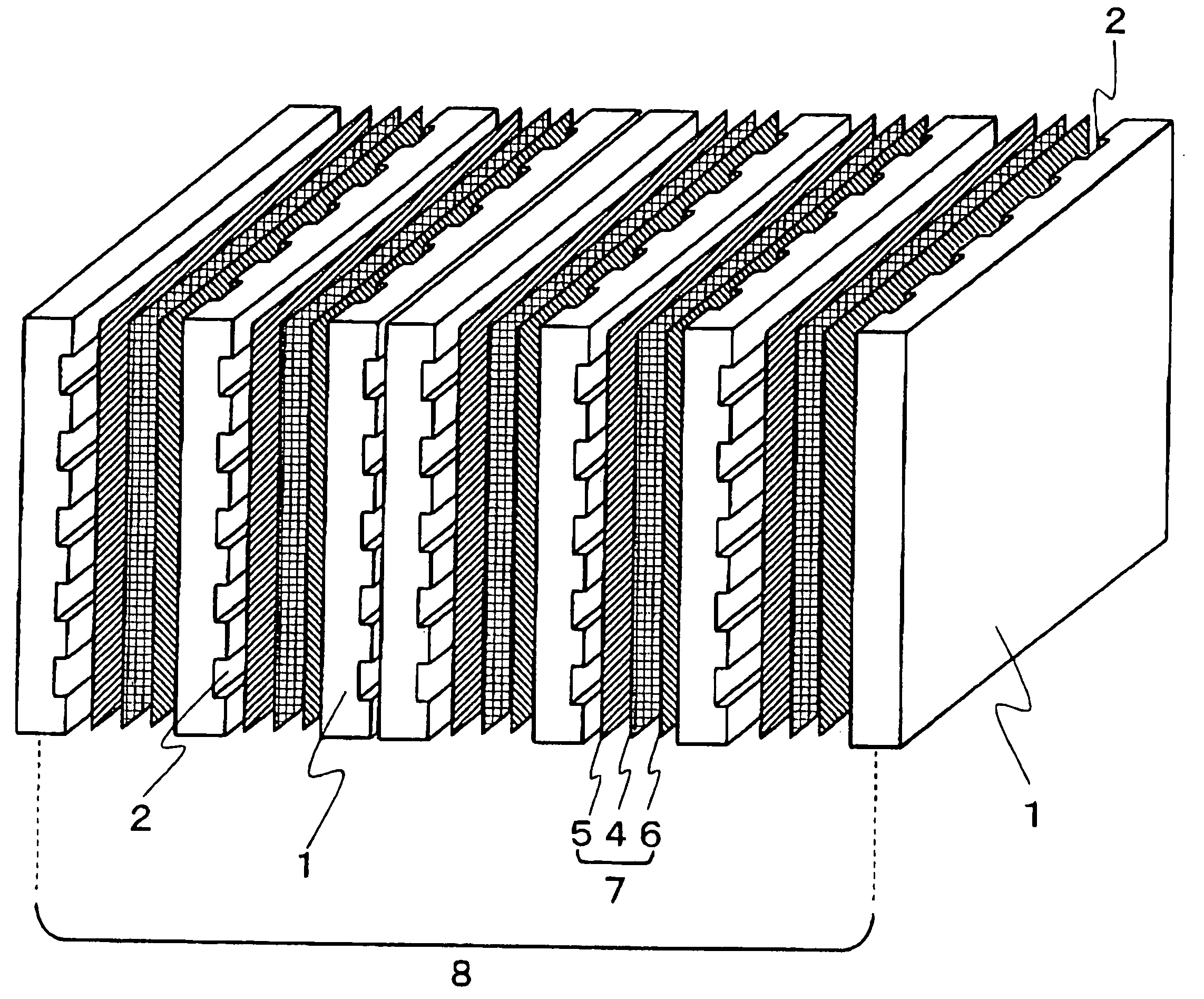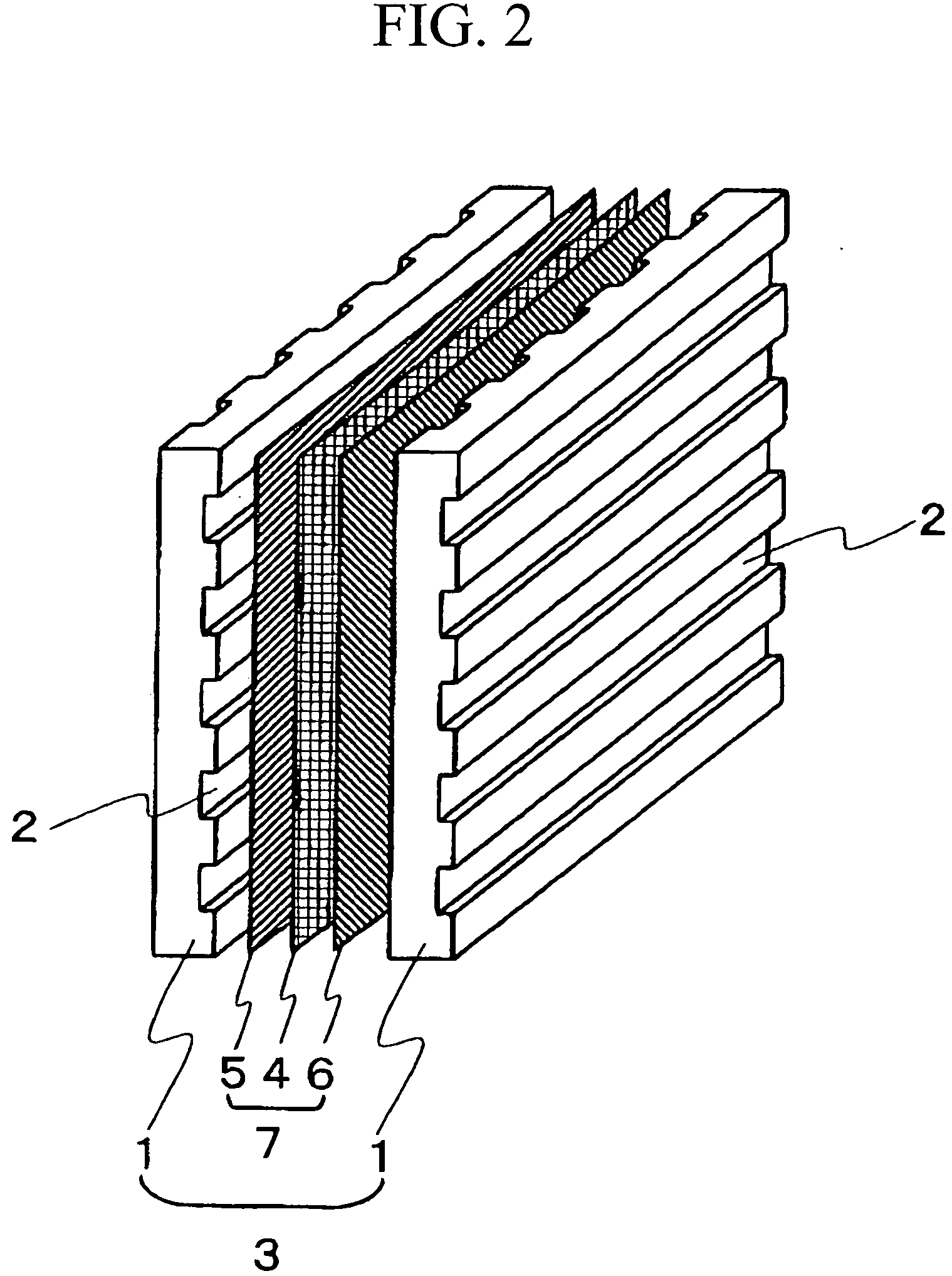Method for producing separator for fuel cell, separator for fuel cell and fuel cell
a technology for separators and fuel cells, applied in the direction of non-metal conductors, cell components, sustainable manufacturing/processing, etc., can solve the problems of reducing the gas sealing ability of bipolar plates, reducing particle size, and unable to achieve the desired electrical conductivity, and achieve excellent power generation efficiency.
- Summary
- Abstract
- Description
- Claims
- Application Information
AI Technical Summary
Benefits of technology
Problems solved by technology
Method used
Image
Examples
example 1
[0127] Eighty parts by weight of synthetic graphite (irregularly shaped; average particle size of 88 μm) as the conductive powder and 20 parts by weight of polyphenylene sulfide resin staple fibers (diameter, 1 μm; length, 1 mm) as the thermoplastic resin fibers were mixed in an air mixer while fibrillating the thermoplastic resin fibers. The resulting mixture was fed to a nozzle having an orifice of circular diameter while at the same time ejecting compressed air from a compressed air inlet located just upstream of the nozzle. The mixture is made to strike a baffle located in front of the nozzle, thereby fibrillating the thermoplastic resin fibers and also causing the conductive powder to disperse. The thermoplastic resin fibers and the conductive powder are then collected, forming a conductive powder-containing fiber web. This fiber web was passed through pressure rolls heated to 300° C., which is above the resin melting temperature (280° C.), and to give a nonwoven fabric of 0.25...
example 2
[0129] Aside from using 70 parts by weight of synthetic graphite (irregularly shaped, average particle size, 88 μm) as the conductive powder and 30 parts by weight of polyphenylene sulfide resin staple fibers (diameter, 1 μm; length, 1 mm) as the thermoplastic resin fibers, a nonwoven fabric was obtained using the same method and conditions as in Example 1.
[0130] The nonwoven fabric was cut into thirty pieces of given dimensions (250×250 mm) conforming to the bipolar-plate shape, followed by the 30 pieces being stacked and heated in a furnace to 300° C., thereby melting the polyphenylene sulfide resin. The nonwoven fabric was then immediately fed in the molten state to a mold loaded into a press molding machine and heated to 150° C., where it was molded under 60 MPa of pressure, then allowed to cool and solidify. This yielded a ribbed molding having a width of 25 cm, a thickness of 2 mm, and a length of 25 cm of the shape shown in FIG. 4. The molding cycle was 30 seconds.
[0131] A ...
example 3
[0132] Aside from using 80 parts by weight of synthetic graphite (irregularly shaped; average particle size, 88 μm) as the conductive powder and 20 parts by weight of polyolefin resin staple fibers (diameter, 1 μm; length, 1 mm) as the thermoplastic resin fibers, a fiber web was formed using the same method and conditions as in Example 1. This fiber web was passed through pressure rolls heated to 190° C., giving a nonwoven fabric of a specific thickness (thickness, 0.25 mm; porosity, 75%).
[0133] The nonwoven fabric was cut into thirty pieces of given dimensions (250×250 mm) conforming to the bipolar-plate shape, followed by the 30 pieces being stacked together and heated in a furnace to 190° C., thereby thoroughly melting the polyolefin resin staple fibers. The nonwoven fabric was then immediately fed in the molten state to a mold heated to 100° C. Next it was molded under 60 MPa of pressure in a press molding machine, then allowed to cool and solidify. This yielded a ribbed moldin...
PUM
| Property | Measurement | Unit |
|---|---|---|
| Diameter | aaaaa | aaaaa |
| Porosity | aaaaa | aaaaa |
| Electrical resistivity | aaaaa | aaaaa |
Abstract
Description
Claims
Application Information
 Login to View More
Login to View More - R&D
- Intellectual Property
- Life Sciences
- Materials
- Tech Scout
- Unparalleled Data Quality
- Higher Quality Content
- 60% Fewer Hallucinations
Browse by: Latest US Patents, China's latest patents, Technical Efficacy Thesaurus, Application Domain, Technology Topic, Popular Technical Reports.
© 2025 PatSnap. All rights reserved.Legal|Privacy policy|Modern Slavery Act Transparency Statement|Sitemap|About US| Contact US: help@patsnap.com



